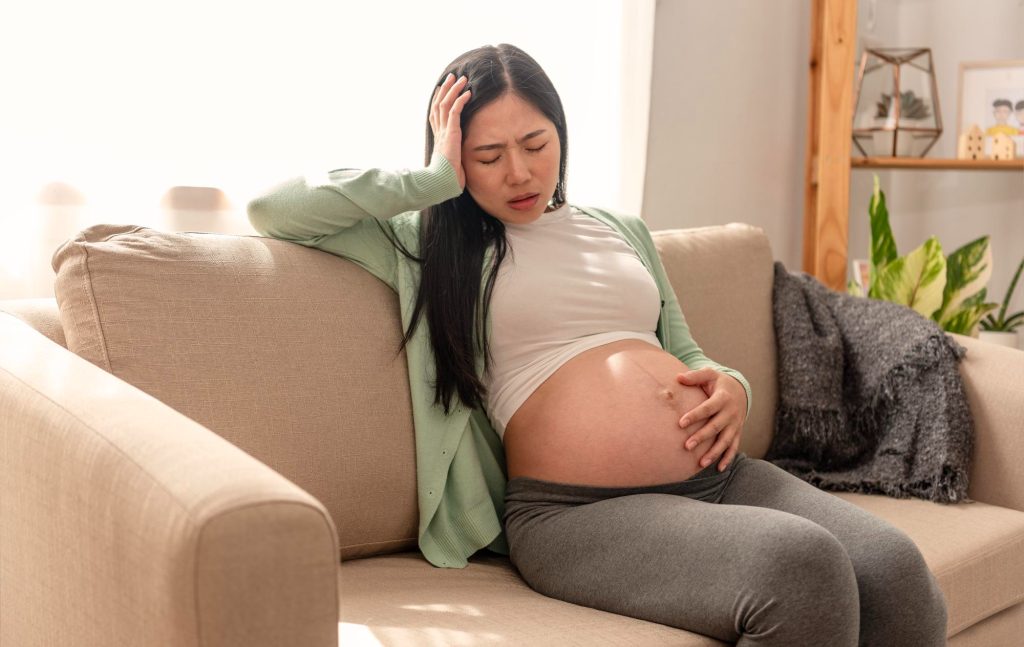Discover the potential complications that can arise during pregnancy when experiencing pelvic girdle pain.
Can Pelvic Girdle Pain Indicate Complications During Pregnancy?
Are you expecting a little bundle of joy? Congratulations! Pregnancy is an incredible journey filled with excitement, anticipation, and, of course, hormonal roller coasters. But along with all the joys, there can be some discomforts as well. One such discomfort that some pregnant women experience is pelvic girdle pain. Now, you might be wondering, does this pain indicate any complications during pregnancy? Well, let’s dive into the world of pelvic girdle pain and find out!

Understanding Pelvic Girdle Pain
First things first, let’s define pelvic girdle pain. Also known as symphysis pubis dysfunction (SPD) or simply pelvic pain, it refers to discomfort and pain in the pelvic area during pregnancy. This pain is often caused by the loosening of the ligaments and joints in the pelvis, which happens due to hormonal changes preparing your body for childbirth.
During pregnancy, your body goes through numerous changes to accommodate the growing baby. One of these changes is the release of hormones, such as relaxin, which help to relax and loosen the ligaments in your pelvis. This increased flexibility allows the pelvis to expand during childbirth. However, it can also lead to pelvic girdle pain as the joints become more mobile and less stable.
There can be several factors contributing to pelvic girdle pain. These can include weight gain, changes in your posture, the position of your baby, and even the way your joints move. As your baby grows, the additional weight can put strain on your pelvic joints, leading to discomfort and pain. Changes in posture, such as an increased arch in your lower back, can also contribute to pelvic girdle pain. Additionally, the position of your baby, particularly if they are in a breech position or pressing on your pelvis, can exacerbate the pain. The way your joints move, including any imbalances or misalignments, can also play a role in the development of pelvic girdle pain.
Now that we know what pelvic girdle pain is, let’s take a closer look at its symptoms. If you experience any of the following, it might be a sign that pelvic girdle pain is making an appearance in your pregnancy:
- Discomfort and pain in the pubic area, lower back, buttocks, or hips
- Difficulty when walking, climbing stairs, or performing daily activities
- A clicking or grinding sensation in the pelvic area
These symptoms can range from mild to severe and can vary from person to person. Some women may only experience occasional discomfort, while others may have constant pain that affects their daily activities. It’s important to listen to your body and seek support if you’re experiencing any pain or discomfort during pregnancy.
Remember, every pregnancy is unique, so the intensity of pain can vary from person to person. If you’re unsure whether what you’re experiencing is pelvic girdle pain or something else, it’s always best to consult your healthcare provider for a proper diagnosis.
Pelvic Girdle Pain and Pregnancy
Prevalence of Pelvic Girdle Pain in Pregnant Women
Now, let’s talk numbers! How common is pelvic girdle pain among pregnant women? Well, studies suggest that around 20% of expectant mothers experience some degree of pelvic girdle pain during their pregnancy. So, if you’re one of the many women feeling this discomfort, you’re certainly not alone!
But what exactly is pelvic girdle pain? Pelvic girdle pain refers to the discomfort or pain that is felt in the pelvic area during pregnancy. It can range from mild to severe and can be experienced in various parts of the pelvis, including the lower back, hips, groin, and buttocks. The pain may be constant or intermittent, and it can worsen with certain activities such as walking, climbing stairs, or standing for long periods.
Research has shown that pelvic girdle pain tends to occur more frequently in the second and third trimesters of pregnancy. This is believed to be due to the hormonal and biomechanical changes that happen in a woman’s body during this time. The increased levels of relaxin, a hormone that helps to loosen the ligaments in preparation for childbirth, can lead to instability in the pelvic joints and contribute to the development of pelvic girdle pain.
Impact of Pregnancy on Pelvic Girdle Pain
It’s important to note that pelvic girdle pain is often a transient condition that resolves after you give birth. So, while it may cause discomfort during your pregnancy, it typically doesn’t indicate any long-term complications.
However, it’s worth mentioning that severe cases of pelvic girdle pain may affect your daily functioning and overall well-being. The pain can make it challenging to perform simple tasks like getting in and out of bed, sitting for extended periods, or even turning over in bed at night. This can have a significant impact on your quality of life and may lead to feelings of frustration, fatigue, and even depression.
Fortunately, there are various management strategies available to help alleviate pelvic girdle pain and improve your overall comfort. These may include physical therapy, exercises to strengthen the pelvic muscles, the use of supportive belts or braces, and modifications to your daily activities. It’s important to consult with your healthcare provider to determine the most suitable approach for your specific situation.
In addition to seeking professional help, there are also self-care measures that you can take to manage pelvic girdle pain. These may include practicing good posture, avoiding activities that exacerbate the pain, using heat or cold packs to relieve discomfort, and engaging in relaxation techniques such as prenatal yoga or meditation.
Remember, every pregnancy is unique, and what works for one woman may not work for another. It’s essential to listen to your body, communicate your concerns with your healthcare provider, and seek the support you need to navigate this period with as much comfort as possible.
Complications Associated with Pelvic Girdle Pain
Pelvic girdle pain is a common discomfort experienced by many pregnant women. While it generally does not pose any direct risk to you or your baby, severe and persistent pain can lead to a range of secondary issues that can affect your overall well-being.
One of the potential complications associated with pelvic girdle pain is sleep disturbances. The discomfort and pain can make it challenging to find a comfortable position to sleep in, leading to disrupted sleep patterns. This lack of quality sleep can leave you feeling tired and fatigued during the day, impacting your ability to carry out daily activities.
In addition to sleep disturbances, pelvic girdle pain can also make it difficult to maintain an active lifestyle. The pain may limit your ability to engage in physical activities, such as exercising or even walking for extended periods. This can be frustrating for those who enjoy an active lifestyle and may contribute to feelings of physical and emotional distress.
However, it’s important to note that in the majority of cases, pelvic girdle pain will resolve on its own after childbirth. The body undergoes significant changes during pregnancy, and as the hormones return to their pre-pregnancy levels, the pain typically subsides. This means that you can look forward to relief and a return to your normal activities in due course.
Nevertheless, it’s always important to keep an open line of communication with your healthcare provider to address any concerns or complications that may arise. They can provide you with guidance and support throughout your pregnancy journey, ensuring that you receive the necessary care and treatment to manage pelvic girdle pain effectively.
Long-term Effects of Pelvic Girdle Pain
As you look into the future, you might wonder if pelvic girdle pain could have any long-term effects. The good news is that studies indicate that most women who experience pelvic girdle pain during pregnancy make a full recovery within a year after giving birth.
During the recovery period, it’s essential to listen to your body and give it the time it needs to heal. Engaging in gentle exercises, such as pelvic floor exercises and low-impact activities, can help strengthen the muscles in the pelvic area and promote healing. Physical therapy may also be recommended to address any lingering pain or discomfort.
While the majority of women recover fully, it’s important to note that some individuals may experience persistent pain beyond the one-year mark. In such cases, seeking ongoing medical advice and support is crucial to manage the pain effectively and ensure a good quality of life.
Remember, every pregnancy and every woman’s experience with pelvic girdle pain is unique. By staying informed, seeking appropriate medical care, and taking steps to manage the pain, you can navigate through this discomfort and look forward to a healthy and pain-free postpartum period.
Diagnosis and Treatment of Pelvic Girdle Pain
Diagnostic Procedures for Pelvic Girdle Pain
Getting an accurate diagnosis is crucial to effectively managing pelvic girdle pain. Your doctor may use various methods, including a thorough medical history review, physical examination, and even some imaging techniques, to rule out other causes of discomfort and confirm pelvic girdle pain.
Treatment Options and Pain Management
When it comes to managing pelvic girdle pain, there are several treatment options to explore. Your healthcare provider may recommend a combination of strategies tailored to your specific needs, such as:
- Physical therapy exercises to strengthen your pelvic muscles
- Supportive devices like belly belts or pelvic support bands
- Applying heat or cold to alleviate pain and inflammation
- Pain medications that are safe for use during pregnancy
Remember, what works for one person may not work for another, so it’s important to find the right combination of treatments that work best for you. Always consult your healthcare provider before starting any new treatment or medication.
Prevention and Coping Strategies
Lifestyle Changes to Prevent Pelvic Girdle Pain
While it may not always be possible to prevent pelvic girdle pain altogether, there are some steps you can take to minimize your chances of experiencing it or reduce the intensity of the symptoms:
- Engage in regular physical activity appropriate for your pregnancy stage
- Maintain good posture and avoid activities that strain your pelvis
- Practice pelvic floor muscle exercises to support your pelvic area
- Wear supportive and comfortable footwear
- Use pillows or cushions to support your body while sleeping or sitting

Coping Mechanisms for Managing Pelvic Girdle Pain
Dealing with pelvic girdle pain can be challenging, but there are coping mechanisms that can help you navigate this discomfort:
- Seek emotional support from your partner, family, and friends
- Join support groups or online communities with fellow pregnant individuals
- Try relaxation techniques like deep breathing or prenatal yoga
- Consider complementary therapies like acupuncture or chiropractic care
Remember, even during those tough moments, you are strong, resilient, and creating life like a superhero! So, don’t hesitate to reach out for support and take care of yourself throughout this incredible journey.
In conclusion, pelvic girdle pain can be an uncomfortable companion during pregnancy, but it rarely indicates any complications. While it may hinder your daily activities, it’s usually a temporary condition that resolves after giving birth. Nonetheless, it’s crucial to seek appropriate care and support to manage the pain and discomfort effectively. Remember, you’re not alone, and with the right strategies in place, you’ll get through this chapter of your pregnancy with grace and a smile on your face!



